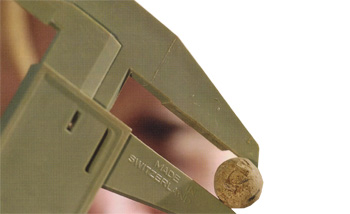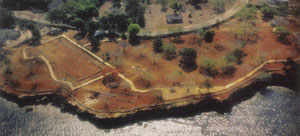A new study provides evidence that the last inhabitants of Christopher Columbus’ first settlement desperately tried to extract silver from lead ore, originally brought from Spain for other uses, just before abandoning the failed mining operation in 1498. It is the first known European extraction of silver in the New World.

Photo by Jeff Gage
Florida Museum of Natural History archaeologist Kathleen Deagan coauthored the study and led the fieldwork at La Isabela, founded in 1493 on modern day Dominican Republic’s north coast. Deagan collaborated with geoscientists and metallurgists to interpret a smelting operation at the site that appeared to have used nearly 200 pounds of galena, a silver-bearing lead ore.
“We first thought they mined the galena locally to extract lead for weapons, such as lead shot and musket balls or ship sheathing,” said Deagan, a distinguished research curator at the Florida Museum “But an isotope analysis showed it was actually from Spain. And metallurgical analysis shows they were trying to extract silver. The archaeological evidence suggested just how desperate the last settlers at the colony were to get precious metal before abandoning the settlement.”
Columbus established La Isabela on his second expedition, which Deagan says was a quest for precious metals. Mining and metallurgy were central elements to the settlement of about 1,500 people — almost all men.

“Columbus really expected and needed to find gold,” she said. “Anytime we recovered evidence for metallurgy — like ore, slag or equipment for smelting — it was important.”
Deagan and her team excavated the galena inside a structure they identified as the royal storehouse, near the front entry. Just outside the entry, they excavated more than 440 pounds of metal slag material. Deagan said it was associated with a fire pit likely used for heating metals.
“All the galena was in the last stratigraphic layer of the storehouse,” Deagan said. “The smelting was one of the last activities to take place.”
Deagan collaborated with other researchers to understand how the settlers processed the materials. She contacted archaeometallurgist David Killick at the University of Arizona and provided samples and funding for his laboratory.
Alyson Thibodeau, a geosciences graduate student working with Killick and lead author of the paper, performed an isotope analysis.

Photo by Jeff Gage
“We found that the samples from La Isabela were extremely consistent with galena found in Spain near the port where the second expedition sailed from,” Thibodeau said.
Deagan was surprised to learn the galena was not mined locally. “So the question was: Why did they haul this heavy, unrefined lead ore all the way from Spain when they could have brought processed lead?” Deagan said.
By consulting with Spanish experts in medieval metallurgy, the team discovered other past uses for galena. In medieval times, they learned, galena was used as flux to draw precious metals from ore matrices and to test their purity. This is likely how La Isabela’s settlers used it.
Killick pieced together the settler’s unconventional use of the galena when he identified the excavated slag as lead silicate — the end product of an improvised smelting process. He discovered tiny specks of silver upon examining the lead silicate with optical and scanning electron microscopy.
“That’s when the penny dropped,” he said. “I realized they were wasting all the lead trying to separate out the silver.”
Deagan said the metal analysis showed the settlers didn’t quite know what they were doing. “They were clearly trying to get the silver out of it,” Deagan said. “But the byproducts showed they had too much of one chemical, but not enough of another. Someone knew a little bit, but not enough.”
The findings were published in the Proceedings of the National Academy of Sciences Feb. 27 print edition.
Additional authors are Joaquin Ruiz, John Chesley and Ward Lyman of the University of Arizona; and José Cruxent of Universidad Nacional y Experimental Francisco de Miranda in Venezuela. The project was funded by the National Science Foundation, Direccion Nacional de Parques de la Republica Dominicana, the National Endowment for the Humanities, the National Geographic Society and the Keck Foundation.
Learn more about the Historical Archaeology Collection at the Florida Museum.